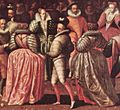Farthingale facts for kids
A farthingale was a special structure worn under women's clothing in Europe during the 1500s and 1600s. Its main job was to make skirts stand out in a specific shape, making the lower part of the body look much wider.
This fashion idea started in Spain in the 1400s. Farthingales were very important for women, especially those in royal courts. Wearing them showed off their high social position and how wealthy they were. This is because a farthingale made a dress need a lot more expensive fabric to cover it, which was a clear sign of riches.
Contents
What Was a Farthingale?
A farthingale was like a frame or a cage worn under a skirt. It helped to give the skirt a very wide and stiff shape. Imagine a bell or a wheel; farthingales helped skirts look like that.
These structures were usually made from wicker, wood, or whalebone. These materials were strong enough to hold up heavy fabrics. They were often covered with linen or other cloths to make them more comfortable to wear.
Why Were Farthingales Worn?
Farthingales were not just about fashion; they were also about showing off. In the Renaissance period, how you dressed told everyone about your place in society. The bigger and more elaborate your clothes, the more important you seemed.
Wearing a farthingale meant your dress used a lot of fabric. Fabric was very expensive back then, especially fine silks and velvets. So, a large skirt supported by a farthingale was a clear sign that you had a lot of money and high status.
Different Kinds of Farthingales
There were a few main types of farthingales that became popular over time. Each one created a different shape for the skirt.
The Spanish Farthingale
The first type was the Spanish farthingale, also known as a verdugado. It was shaped like a cone or a bell. This farthingale had hoops of cane or wire that got bigger as they went down. These hoops were sewn into a fabric underskirt. This made the skirt stand out evenly all around the body.
The French Farthingale
Later, around the 1580s, the French farthingale became popular. This one was also called a "wheel farthingale" or "cartwheel farthingale." It was shaped like a flat, wide wheel that sat around the hips. This made the skirt stick out almost horizontally from the waist.
The French farthingale created a very dramatic and wide silhouette. It was often worn with a padded roll called a "bum-roll" to help support the heavy skirts. This style was very popular in England too, especially during the time of Elizabeth I.
Images for kids
-
This portrait of Catherine Parr from 1545 shows the shape of a Tudor gown with a Spanish farthingale underneath.
-
This famous portrait of Elizabeth I shows the very wide silhouette of the 1590s, created by a French farthingale.
See also
 In Spanish: Verdugado para niños
In Spanish: Verdugado para niños





